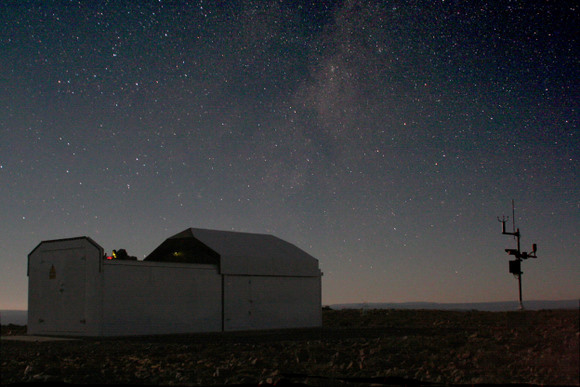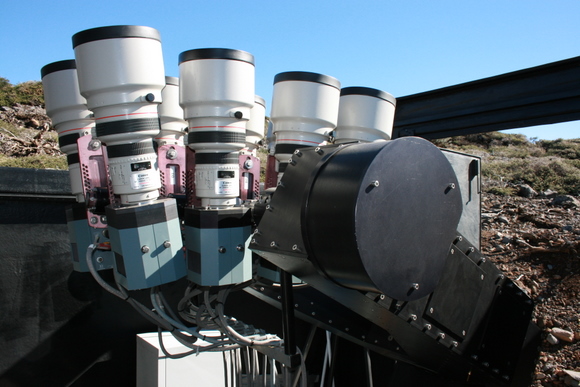The United Kingdom’s Wide Area Search for Planets, known as SuperWASP consists of two 8-camera robotic observatories that cover both hemispheres of the sky. In the past 6 months an international team of astronomers have used these unique observatories to discover 10 new extra-solar planets, making SuperWASP the most successful planet-hunting observatory in the world. The discovery of these planets was announced on April 1 by Dr. Don Pollacco of Queen’s University in Belfast at the Royal Astronomy Society’s National Astronomy Meeting in the UK.
All told, scientists have found more than 270 extrasolar planets since the the early 1990s. Most of these are detected through their gravitational influence on the star they orbit. As a planet orbits a star, it tugs the star back and forth. However, making these discoveries depends on looking at each star over a period of weeks or months, making the pace of discovery fairly slow.
But SuperWASP uses a different method. The two sets of cameras watch for events known as transits, where a planet passes directly in front of a star and blocks out some of the star’s light, so from the Earth the star temporarily appears a little fainter. The SuperWASP cameras work as robots, surveying a large area of the sky at once and each night astronomers have data from millions of stars that they can check for transits. The transit method also allows scientists to deduce the size and mass of each planet.
SuperWASP-North is located on the island of La Palma, just off the Northwestern coast of Africa, and SuperWASP-South is at the southern tip of Africa at the South African Astronomical Observatory near Sutherland, South Africa.
The observatories are quite simple, but effective. They use 8 high quality digital cameras to take pictures of the sky and simply measure any changing brightness of the stars.
Each possible planet found using SuperWASP is then observed by astronomers working at the Nordic Optical Telescope on La Palma, the Swiss Euler Telescope in Chile and the Observatoire de Haute Provence in southern France, who use precision instruments to confirm or reject the discovery.
45 planets have now been discovered using the transit method, and since they started operation in 2004 the SuperWASP cameras have found 15 of them, which makes SuperWASP by far the most successful discovery instruments in the world. The SuperWASP planets have a variety of masses, between a middleweight 0.5 and a huge 8.3 times that of Jupiter. A number of these new worlds are quite exotic. For example, a year on WASP-12B (its orbital period) is just 1.1 days. The planet is so close to its star that its daytime temperature could reach a searing 2300 degrees Celsius.
Dr. Pollacco is delighted with the results. “SuperWASP is now a planet-finding production line and will revolutionize the detection of large planets and our understanding of how they were formed. It’s a great triumph for European astronomers.â€
Original News Source: Royal Astronomy Society press release



Holy hell look at all those L-lenses!
I wonder what’s their focal length…
Focal length is 200 mm at f/1.8.
More info can be found here:
http://www.superwasp.org/technical.htm
Awesome instrument! With quality instrumentation like this, the number of known exo-planets will almost certainly explode, and hopefully as instruments improve, we’ll start to see a smattering of star systems that more closely resemble our own. I just can’t wait until we start to approach the sensitivity that will allow us to pin our first Earth-size (and smaller) planets!
Once we nail a few Earth-size planets around habitable zones in other star systems (which would seem like only a matter of time now), I think the funding will start to ramp up for space-based interferometers and the like. Potentially habitable worlds are one of those rare few things that would really capture the public imagination – like Sputnik, Apollo and Hubble before it…
Another wonderful piece of our future of astronomy at work 🙂
Why havent we sent out a giant Hubble sized (or larger) telescope out to the far reaches of our solar system? I know it would be costly. But imagine having Hubble out near the HelioSphere. The new discoveries we could make with this would be beyond any of our wildest dreams. I think Earth like planets would start being discovered on a daily basis.
And sorry for a lack of better words here, but that would be sweeeeetttt!!!
We can see original space objects within 150 million kilometer. Ahade of it everything is mere image into space mirror. It can not explain in short. . Therefore it invites to visit http://www.spacemirrormystery.com to know the original truth
wonderful piece